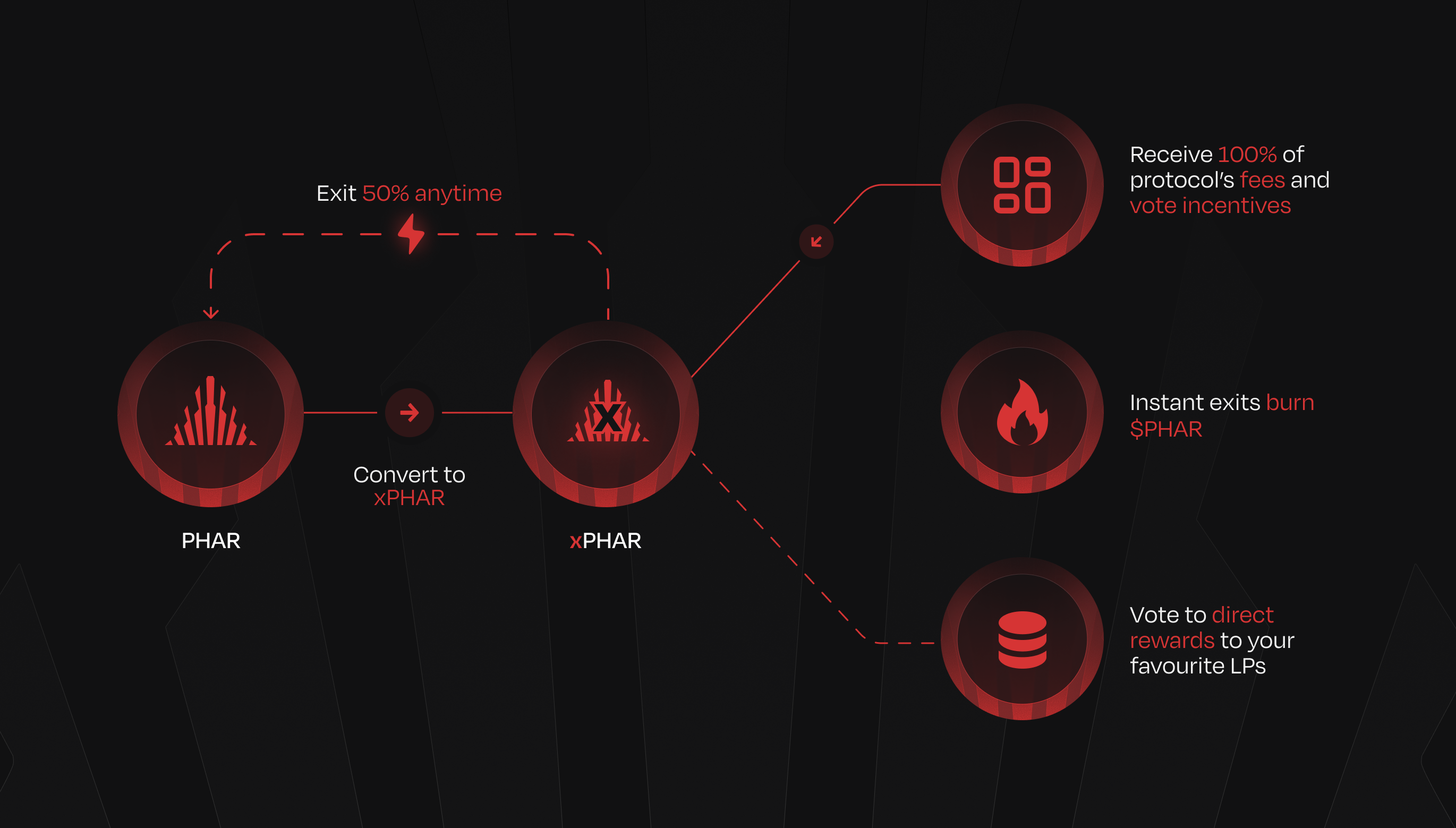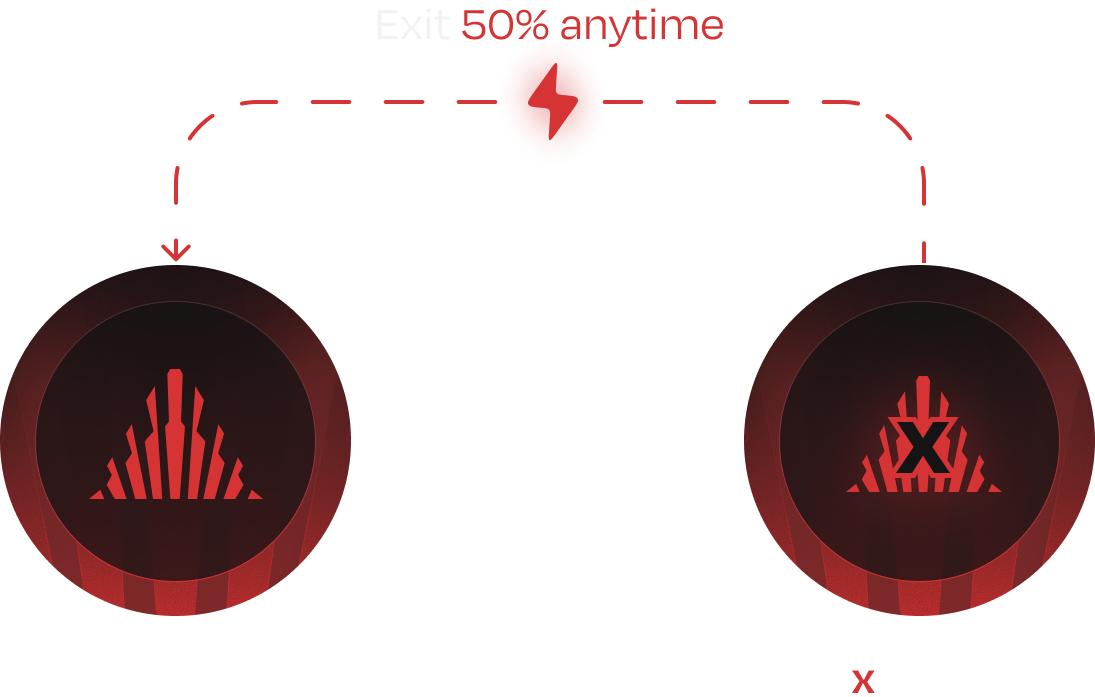Core concepts
xPHAR
What is xPHAR?

xPHAR is a token developed by the Pharaoh team to address the sustainability challenge associated with earlier metaDEX models. xPHAR combines the best of vote-escrow models with the flexibility of traditional escrow incentive systems.
No more lengthy lock-ups to participate fairly in an ecosystem.
What can I do with xPHAR?
xPHAR stakers can vote to direct emissions to their favorite LP pairs. By staking, they earn 100% of protocol fees, vote incentives, and penalties from exits.

Token
xPHAR is a non-transferable representation of 1 unit of PHAR held in escrow within the xPHAR smart contract. Only holders of xPHAR have voting rights on Pharaoh. While xPHAR itself is non-transferable, it offers users the ability to exit their position when needed.
How is xPHAR obtained?
Users can acquire xPHAR through vote incentives, token emissions, or by converting PHAR.

PHAR > xPHAR conversion
PHAR can be freely converted into xPHAR at any time. The process is instant, and the ratio is 1:1.
How to exit xPHAR?

xPHAR > PHAR redemption
Users can exit their xPHAR position in two ways:
- Direct redemption: Convert xPHAR back to PHAR instantly with a 50% penalty (1:0.5 ratio)
- Liquidity exit: Use p33, the liquid staked version of xPHAR, to trade your position on the open market
Instant exit means forfeiting 50% of the underlying PHAR.
xPHAR Burn to Mint
Pharaoh incorporates a unique deflationary take on traditional staking models which is designed to create genuine scarcity and reward long-term holders through supply reduction rather than redistribution.
50% of PHAR tokens used to mint xPHAR are permanently burned during the minting transaction, creating real supply constriction and sustained deflationary pressure on the underlying PHAR token.
This burn mechanism ensures that every new xPHAR position contributes to reducing the total PHAR supply, creating value for all PHAR holders while incentivizing thoughtful entry into xPHAR positions.
Why?
As discussed in the Origins of metaDEX, metaDEX introduced important improvements to user alignment but still had fundamental limitations. xPHAR builds on these improvements while addressing the core issues, moving the power balance back towards users. Instead:
- Each xPHAR mint permanently reduces PHAR supply, benefiting all token holders
- Users must commit meaningful value to enter, ensuring only serious participants
- The deflationary pressure creates sustained upward pressure on PHAR value
- Any size can participate, unlike liquid wrappers (limited liquidity) or veNFTs that are large to sell (pseudo-liquid)
Voting Incentives
xPHAR holders are rewarded for actively participating and voting—earning 100% of protocol fees and vote incentives. When you vote for liquidity with gauges, you receive a proportionate share of all fees generated by that liquidity, plus any additional vote incentives offered by protocols to attract emissions.
| Trading Fees | Vote Incentives |
|---|---|
| 100% of trading fees on liquidity you vote for | Additional rewards offered by protocols to attract votes to their pairs |
- Both fees and vote incentives are claimable immediately after Epoch flip.
- Vote incentives can be in any whitelisted token, learn more.
Voting Breakdown
The main purpose of the xPHAR token is to vote to direct emissions to liquidity. This is achieved through weekly voting for gauged liquidity. Emissions are distributed proportionally to the total percentage of votes in the Epoch.
Emission Calculation
The expected emissions can be calculated using a simple division formula:
For example, 100,000 PHAR is distributed in a single epoch. If 10% of all votes are allocated to the PHAR / USDC pair, that pair will receive 10,000 PHAR tokens distributed linearly to liquidity providers of the relevant LP pair throughout the epoch.
Vote Weight Calculation
The voting power of xPHAR is determined by:
- Amount of xPHAR held
- Active participation in voting
- Epochs reset every Thursday at 00:00 UTC
- Votes determine emission distribution for the following week
- Emissions are distributed linearly throughout the epoch
Active Staking
Active staking is a key improvement in xPHAR's design over traditional metaDEX systems. While other protocols automatically distribute rebases to all holders, xPHAR requires users to be staked to earn vote incentives and rebases.
Requirements
To be eligible for ALL weekly rewards, xPHAR holders must:
- Have xPHAR staked
- Cast votes during that epoch
If you do not stake xPHAR before the epoch flip you will not receive any rewards for that epoch.
This design choice ensures incentives flow to active participants who are staked and vote every epoch, rather than having passive holders accumulate rewards without contributing.
Liquid Staking
Pharaoh was designed to eliminate friction from the metaDEX model, and managing voting positions is one of the biggest sources of this friction. The liquid staked version of xPHAR simplifies this process by automating voting and reward claims without disrupting xPHAR's core mechanics.
Before each epoch flip, there is a 1-hour period where liquid staking tokens cannot be minted so votes can be calculated.
p33
p33 is the liquid staked version of xPHAR and can minted with xPHAR. The p33:xPHAR ratio starts at 1.00:1.00 and increases in p33's favor as rewards accrue from fees, vote incentives and rebases.
| Feature | Benefit |
|---|---|
| Automated Voting | Voting algorithm for mathematically perfect voting |
| PHAR Buybacks | Sells rewards for PHAR using aggregators for optimal execution |
| Auto-compounding | All vote incentives and fees increase the p33:xPHAR ratio |
| Claims Rebase | Claims rebase and which also increases the p33:xPHAR ratio |
| Zero Fees | No costs for deposits, withdrawals, or compounding |
| Full Liquidity | Trade freely on open market unlike staked xPHAR positions |
| Price Protection | Cannot trade below xPHAR redemption value (instant exit) |
| p33.ratio() ⬆️ | p33:xPHAR ratio always increases from rewards |
After every weekly epoch flip rewards from fees and vote incentives are automatically sold to increase the p33:xPHAR ratio, this increase includes rebases from user and emission exits. Below is an example showing how p33:xPHAR ratio will increase over time.
Does not bypass exit fee
While p33 offers instant liquidity, it doesn't circumvent xPHAR's exit penalties. As the liquid staking version of xPHAR, p33's market price naturally reflects the instant exit fee structure. The token cannot trade below the xPHAR redemption value because arbitrageurs would immediately buy and redeem p33 for xPHAR to capture the difference. While p33 cannot trade below the xPHAR instant exit penalty, it may trade at a premium to this based on market dynamics.
After each epoch flip while rewards are being sold and compounded, there is a 24-hour TWAP buyback period during which new p33 cannot be minted from xPHAR. Withdrawals are not affected, you can still withdraw your xPHAR during this period.